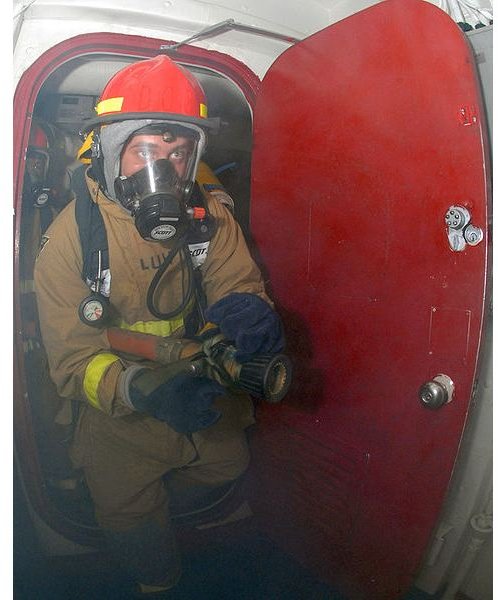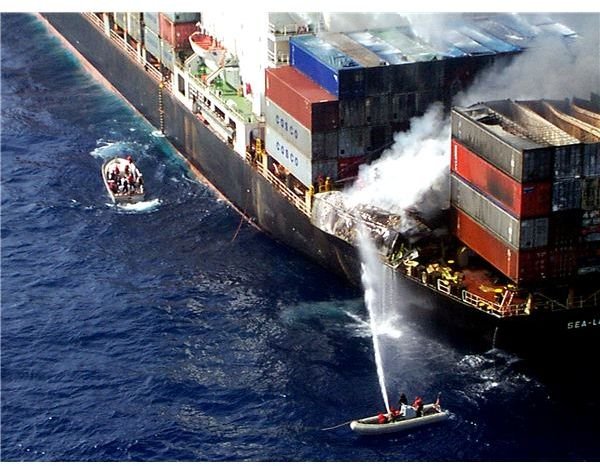Fire / Explosion - In Ships
Ship on Fire
We have been studying about various situations involving fire on board a ship. We also studied about two specific situations involving fire in a cargo hold at sea, as well as shore cargo hold fire. Basically these articles deal with specific situations and actions to be taken. In this article we will study about a generic situation where fire is involved.
As you must be aware fire and explosion often go hand in hand. An explosion can lead to a fire; and a fire can lead to an explosion. So whenever there is either of the two, it is quite safe (unsafe actually) to assume that the other might follow suit. Hence it is necessary to follow fire and explosion principles and procedures, lest the proportion of damage goes out of hand.
- Raise the Emergency alarm.
- Determine Location of the fire/explosion.
- Check for oil/hazardous substances,pollution & possibility of one.
- Determine any casualties and provide FIRST AID if necessary.
- Find out the type of fire.
- If necessary start the fire pump.
- In case of engine room fire start the emergency fire pump and close the isolating valve.
- Close all the QCVs (quick closing valves).
- Contain and extinguish the fire (using fixed system if necessary).
- Set up emergency distress transmitter and keep ready for use.
IN PORT
Stop cargo work, evacuate shore personnel, keep main engine ready and inform port and fire authorities.
Ship on Fire

Power Failure
Trouble seldom comes alone, and sometimes it may so happen that apart from handling the fire and/or explosion, there might be a blackout situation. The following additional steps must be taken apart from the previously mentioned points.
- Revet to manual steering and use the magnetic compass for heading.
- Engineers to rectify fault and revert to normal power.
- Take whatever actions are necessary to maintain the vessel in a safe position
- If emergency power did not cut-in and the vessel is unable to maneuver safely, SECURITE message must be broadcast and display NUC (Not Under Command) Signals.
As you know, there are several teams which are pre-divided and every one on the ship knows his/her team and location or muster point. The duties of the various teams including the main command center team have been described briefly as follows
Command Team Duties
- Fix the ship position and record all movements /events.
- Compile communication reports and monitor weather condition.
- Inform the technical department and designated person and advise them of the status.
- Determine the possibility of sinking, breaking up or capsizing in due course.
- Exhibit the required signals and broadcast a distress/urgency/safety messages as per the circumstances.
- Inform the relevant authorities and for shore assistance required.
Emergency Team Duties
- Chief officer is to be incharge of any deck emergency.
- 2nd engineer to incharge of any engine emergency.
- Identify and assess the source and report to Command Center.
- Contain and extinguish the fire.
- check for oil pollution and act accordingly.
- Check stability criteria and stress.
- Assess extent of damage to vessel / cargo.
Support Team Duties
- Provide first aid.
- Prepare life boats.
- Shut all water tight door and vents.
- Assist as directed.
Engineer’s Team Duties
- Attend to ship’s engine room services and controls.
- Report the status of main engine and auxiliary equipment to the command centre.
- stop vents and isolate electrical supply if required.
As these are the various duties to be performed by the crew members in case of fire on board.
Image credits
defenselink.mil - Ship in fire
Wikipedia Images - Emergency Team on Board
This post is part of the series: Emergency Preparedness - Different Types of Emergency Situation On Board
Emergency response plan is important onboard the ship as this gives the duties and responsibility to be performed by crew members during the emergency situations on board. This series will give you the idea of different types of emergency situation on board the ship.
